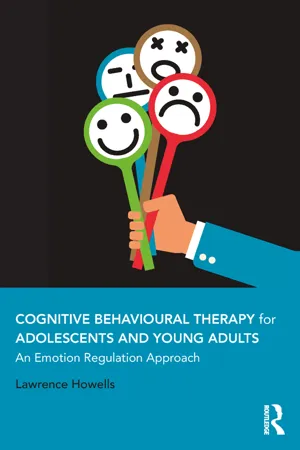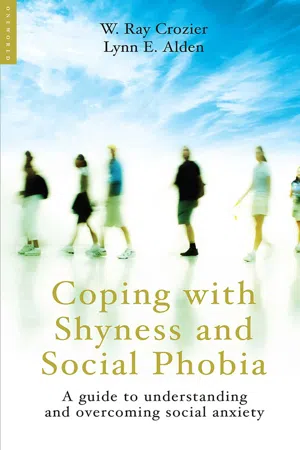Cognitive Behavioural Therapy
Cognitive Behavioral Therapy (CBT) is a type of psychotherapy that focuses on identifying and changing negative thought patterns and behaviors. It is based on the idea that our thoughts, feelings, and actions are interconnected, and by altering our thoughts and behaviors, we can improve our emotional well-being. CBT is often used to treat various mental health conditions, including anxiety, depression, and phobias.
6 Key excerpts on "Cognitive Behavioural Therapy"
- eBook - ePub
How to Use Social Work Theory in Practice
An Essential Guide
- Malcolm Payne(Author)
- 2020(Publication Date)
- Policy Press(Publisher)
...15 Cognitive Behavioural Therapy (CBT) practice Setting the scene What is CBT? Cognitive Behavioural Therapy (CBT) involves specifying behaviours and cognitions (thinking) that cause problems for clients and people around them. Through carrying out a sequence of procedures, you enable people to expunge, limit or manage the impact of those behaviours and thinking on their lives. The main sources are in psychology and psychotherapy: modern CBT combines decades of research into learning theory, social learning theory and cognitive therapies. An important cognitive psychologist, Beck (1976), has been influential. Thoughtful collections of social work interpretations are, in the UK, Cigno and Bourn (1998) and in the US, Ronen and Freeman (2007). Aims There are three connected aims: • to change entrenched behaviour that clients want to change but are finding difficult to achieve; • to change ways of thinking that are making life tasks and relationships difficult to manage; • to help people improve how they feel, think, motivate themselves and behave in dealing with social situations. Uses Agencies using CBT are usually in the fields of child and adolescent or adult psychiatry, but many other applications are possible. To use CBT fully, you need specialist supervision and training, usually as part of a programme of provision in your agency. Some agencies train staff on brief courses to use aspects of CBT for specific problems that commonly arise in their work, for example anxiety and depression in end-of-life care; school phobia. Where you want to use CBT, but specialized social work supervision is not available, clinical psychologists can sometimes provide supervision. Using CBT principles brings clarity to wider social work practice, a step onwards from task-centred practice. Many clients and their families appreciate the way it helps them tackle specific troubles in their lives...
- eBook - ePub
- David B. Cooper(Author)
- 2016(Publication Date)
- CRC Press(Publisher)
...In the author’s view, the scientist-practitioner model is fundamental to how CBT is defined as a treatment modality. WHAT IS Cognitive Behavioural Therapy? KEY POINT 10.1 Cognitive Behavioural Therapy (CBT) is a structured, problem-solving treatment that has a strong evidence base 19, 20 in the treatment and management of anxiety disorders and depression. Cognitive Behavioural Therapy is a structured, problem-solving treatment that has a strong evidence base 19, 20 in the treatment and management of anxiety disorders and depression. The clinical focus of CBT is on the individual’s current problems, with the aim of equipping the person with practical skills to tackle problems that interfere with her/his day-to-day functioning. The treatment is goal-orientated, in that goals are agreed between the individual and professional, usually in terms of improving current problems in three domains, namely: 1 practical day-to-day problems 2 intrapersonal problems 3 interpersonal problems. 21 Each step of the CBT assessment and treatment process is explicitly shared with the individual and the foundation of the therapeutic relationship (see Chapter 2) is collaborative empiricism. In this paradigm the individual and professional work together to make psychological sense within a CBT model of what factors are maintaining the person’s problems. This is referred to as a maintenance formulation 22 and is shared with the person as a hypothesis to be tested during treatment. Thus, a central aspect of treatment is the use of what is referred to as behavioural experiments 23 to test out hypotheses in order to collect evidence to validate or refute these hypotheses. The evidence collected is then used to devise further behavioural experiments in order to solve problems and to develop different ways of experiencing self and others and new ways of acting in the world. A word of caution It needs to be acknowledged that there are a many different ‘schools’ of Cognitive Behavioural Therapy...
- eBook - ePub
- Naomi Moller, Andreas Vossler, David W Jones, David Kaposi(Authors)
- 2020(Publication Date)
- SAGE Publications Ltd(Publisher)
...Chapter 10 Cognitive Behavioural Therapy Simon P. Clarke Contents Introduction 285 1 Core CBT principles and their development 287 1.1 The development of the CBT approach 288 2 The cognitive behavioural understanding of mental health 292 3 Therapeutic process and technique in CBT 297 4 The efficacy and scope of the CBT approach 303 Conclusion 306 Further reading 307 References 308 Introduction ‘Obfuscation’ by Victor Guerrero Cognitive Behavioural Therapy (CBT) is a psychotherapeutic approach characterised by its emphasis on the role of reasoning processes to treat mental health difficulties. It has been applied to a range of problems, from anxiety, depression and psychosis to addictions, relationship difficulties, neuropsychological conditions and physical health. It is the most widely-researched psychotherapy in terms of quantitative and medical research, with its success often attributed to the way it has methodologically allied itself with evidence-based medicine through its extensive use of the randomised controlled trial. CBT has incorporated ‘common-sense’ conceptualisations of everyday difficulties in a manualised treatment format that is replicable in different service contexts...
- eBook - ePub
Cognitive Behavioural Therapy for Adolescents and Young Adults
An Emotion Regulation Approach
- Lawrence Howells(Author)
- 2018(Publication Date)
- Routledge(Publisher)
...Chapter 3 Principles of Cognitive Behavioural Therapy (CBT) There’s no magic bullet cure, you have to work at it, plough away at it. (21-year-old male) It felt helpful to lay a foundation in my past experience [genogram]. Seeing it all written out like that really does help. (22-year-old male) It is important to hold in mind the principles of CBT and the components of the approach associated with its efficacy. This chapter provides an outline of the historical context of CBT, before looking in more detail at the theoretical principles underpinning its practice today. It then considers the practical constructs of CBT and the evidence base upon which CBT has been built. History of CBT Freudian psychoanalysis dominated psychotherapy for the early part of the twentieth century. It is characterised by an emphasis on early events that are thought to continue to influence current attitude, mannerisms, emotion and thought via irrational and unconscious drives. With the growth of psychology as a rigorous scientific discipline, psychoanalysis came under increasing criticism due to its focus on constructs that could neither be observed nor measured, and a lack of empirical evidence to support either its theory or its effectiveness (Eysenck, 1952). Behaviourism, a powerful movement in experimental psychology, took a different view, working with only what was observable and measurable, the assumption being that what went on inside the mind was not observable and therefore not amenable to scientific study. Behavioural therapy followed from this movement and provided a compelling alternative to the prevailing psychoanalytic view...
- eBook - ePub
Anxiety and Cognition
A Unified Theory
- Michael Eysenck(Author)
- 2014(Publication Date)
- Psychology Press(Publisher)
...Cognitive therapy or cognitive-behaviour therapy has mostly involved procedures resembling those advocated by Beck and Emery (1985). The rationale for these procedures was described in the following terms by Butler, Fennell, Robson, and Gelder (1991): “anxiety is maintained by anxious thoughts (e.g., about symptoms and about situations that provoke anxiety) and by lack of self-confidence defined as reduced belief in the ability to carry out activities successfully... anxiety can be controlled by learning to recognise anxious thoughts, to seek more realistic and helpful alternatives, and to take action to test these in practice” (p. 169). Durham and Allan (1993) compared cognitive therapy against biofeedback, behaviour therapy, relaxation training, and non-directive psychotherapy. They concluded as follows: “On balance, the best results are likely to be obtained by cognitive therapy, although the few comparative studies suggest that non-specific factors are important” (p.25). Butler et al. (1991) compared the effectiveness of cognitive-behaviour therapy modelled on the procedures of Beck and Emery (1985) with behaviour therapy based on relaxation, graded exposure, and re-engagement in pleasurable and rewarding activities. Butler et al. (1991) concluded that, “results show a clear advantage for CBT [cognitive-behaviour therapy] over BT [behaviour therapy]. A consistent pattern of change favouring BT was evident in measures of anxiety, depression, and cognition” (p.167). Of particular relevance to the approach adopted in this book, the most significant differences between the two forms of therapy were in the reduction in the perceived likelihood of unpleasant threatening events, and in the reduction in the tendency to interpret ambiguous material in a threatening way. Both of these measures showed greater reduction with cognitive-behaviour therapy than with behaviour therapy...
- eBook - ePub
Coping with Shyness and Social Phobias
A Guide to Understanding and Overcoming Social Anxiety
- Ray Crozier, Lynn E. Alden(Authors)
- 2009(Publication Date)
- Oneworld Publications(Publisher)
...7 Psychological therapy What is cognitive behaviour therapy? As we discussed in chapter 6, the most widely used psychological treatment for social anxiety disorder (SAD) is cognitive behaviour therapy (CBT). In this chapter and in chapter 8 we look at CBT change strategies in greater detail. The primary goal of this approach is to change the factors that maintain social anxiety in the present. CBT places particular emphasis on cognitive processes, that is, the way that socially anxious people think about themselves and social events. With this in mind, we begin our discussion of treatment by examining what we know about how thinking helps to maintain social anxiety. This information, which comes from research and clinical observation, will help us understand how CBT works. The importance of what we think The term cognitive refers to mental activity, or thinking. CBT looks at two aspects of thinking. The first is thought content, that is, what we think about. For example, we can think about pleasant or unpleasant topics; we can think about the past, the present or the future; we can think about ourselves or other people, and so on. Socially anxious people tend to think about topics that maintain their anxiety. Before social events, they may think about past events that did not go well. After social events, they may go over and over what happened and focus on negative aspects of the situation. In CBT, therapists help people reduce the amount of time that they spend thinking about negative topics. CBT also looks at the process of thinking, that is, how we think and the way that we arrive at judgements and conclusions about social events. Arriving at judgements is a complicated process in which the mind has to weigh up different pieces of information. For social events, this includes information about the external situation, such as who is present and how they behave. It also includes information about internal experiences, such as emotional states...





